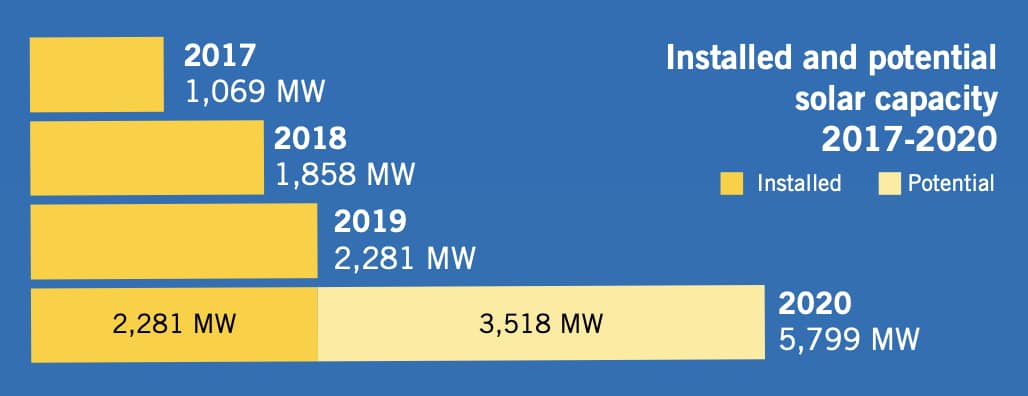Solar capacity in the ERCOT grid region has the “potential” to reach 5.8 GW this year, said ERCOT in its annual “State of the Grid” report. ERCOT serves nearly all of Texas.
Solar capacity in ERCOT has room to grow, as it met less than 2% of the grid’s load last year. Wind power met 20% of the grid’s load, with wind capacity at 24 GW and potentially rising to 33 GW this year. Wind and solar generation developers submitted a “record number of interconnection requests” last year, the report said, and “with more solar projects coming online, wind and solar power have begun to complement each other.”
Summer peak
Solar additions this year should also help serve peak load, which exceeded 74 GW last August 12, and which ERCOT expects to reach just under 77 GW this summer.
ERCOT’s pricing structure, which allowed wholesale rates to briefly reach the maximum $9,000 per megawatt-hour last August, gives all retail providers “a significant incentive” to reduce the impact of wholesale price swings, by entering long-term supply arrangements such as power purchase agreements, in the view of Travis Kavulla, vice president of regulatory affairs for NRG Energy, a retail provider in ERCOT. Solar power purchase agreements, in turn, help solar developers gain the financing needed to build their solar projects.
ERCOT had a “historically low” reserve margin of 8.6% last year, resulting in “some tight grid conditions during the hottest summer months,” said ERCOT’s report. For the first time since January 2014, ERCOT declared an emergency on two occasions during the year. “During both events, ERCOT was able to maintain system reliability using the tools available” once an energy emergency is declared, the report said. The “R” in ERCOT stands for reliability.
Demand response “from electric providers and consumers” met more than 2,000 MW of the need on August 12.
Other grid regions operate with higher reserve margins, which is another way to ensure system reliability, but also means higher costs for customers.
Market improvements
ERCOT launched three initiatives aimed at market improvements last year.
A new task force will draft market protocols for “real-time co-optimization,” or “the process of dispatching energy and ancillary services interchangeably in the real-time market.” Both solar and storage are capable of providing ancillary services.
ERCOT also created a battery energy storage task force, and staff began exploring technical requirements, modeling needs and market rules for battery storage. Battery storage capacity in the ERCOT region stood at 104 MW in 2019 “and is on track to exceed 350 MW by the end of 2020,” said the report.
Also in 2019, ERCOT temporarily limited the interconnection of new “distribution generation resources,” which it defines as “resources that can be compensated by ERCOT for energy and ancillary services,” while the grid operator develops rules and requirements for these resources through a stakeholder process.
This content is protected by copyright and may not be reused. If you want to cooperate with us and would like to reuse some of our content, please contact: editors@pv-magazine.com.








ERCOT will have about 1GW of solar online shortly. I just happened to look at this yesterday. They had 580MW of solar reach Synchronization phase and another 452.5MW reach the Energization phase in April. Barring big issues that means that 1,032.5MW will be on the ERCOT grid in a month or so. ERCOT also had 314MW of wind reach Commercial Operation phase in April with another 389MW in either the Synchronization or Energization phase.
ERCOT phases: Energization->Synchronization->Commercial Operation.
Forgot to mention that solar projects within ERCOT that have an Interconnect Agreement have nearly caught up to wind projects. Wind has 13,022MW of IA, solar has 12,711MW. As far as proposals solar has blown past wind with solar having 76,252MW and wind “only” 27,780MW proposed. Batteries actually have 10,899MW of proposals with 821 having an IA. NG comes in last with 5,084MW of proposals and 1,416MW with an IA.
I’m betting repubs are kicking themselves for an open market grid they thought would keep RE out yet as not burning FFs costs less, Re will take over.
In the south solar is hard to beat as follows the main load peak, A/C near perfectly, especially if tracking or extra more western facing panels.
Since these loads are most expensive solar saves the whole system by cutting it.
Just look at Cal where solar drove the A/C peak completely out of the afternoon into the duck, all that is left most of which would be covered with tracking or extra westward panels.
And cuts the need for storage. A win, win, win except for FFs that will lose big time as Re is so much cheaper, cleaner.
This is what a “disruptive technology” is and it is non-partisan just like the Corona Virus.